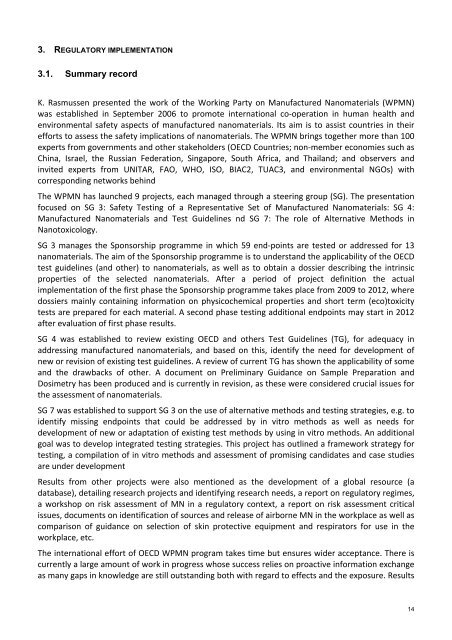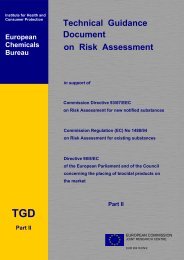Challenges of Regulation and Risk Assessment of Nanomaterials
Challenges of Regulation and Risk Assessment of Nanomaterials
Challenges of Regulation and Risk Assessment of Nanomaterials
Create successful ePaper yourself
Turn your PDF publications into a flip-book with our unique Google optimized e-Paper software.
3. REGULATORY IMPLEMENTATION<br />
3.1. Summary record<br />
K. Rasmussen presented the work <strong>of</strong> the Working Party on Manufactured <strong>Nanomaterials</strong> (WPMN)<br />
was established in September 2006 to promote international co-operation in human health <strong>and</strong><br />
environmental safety aspects <strong>of</strong> manufactured nanomaterials. Its aim is to assist countries in their<br />
efforts to assess the safety implications <strong>of</strong> nanomaterials. The WPMN brings together more than 100<br />
experts from governments <strong>and</strong> other stakeholders (OECD Countries; non-member economies such as<br />
China, Israel, the Russian Federation, Singapore, South Africa, <strong>and</strong> Thail<strong>and</strong>; <strong>and</strong> observers <strong>and</strong><br />
invited experts from UNITAR, FAO, WHO, ISO, BIAC2, TUAC3, <strong>and</strong> environmental NGOs) with<br />
corresponding networks behind<br />
The WPMN has launched 9 projects, each managed through a steering group (SG). The presentation<br />
focused on SG 3: Safety Testing <strong>of</strong> a Representative Set <strong>of</strong> Manufactured <strong>Nanomaterials</strong>: SG 4:<br />
Manufactured <strong>Nanomaterials</strong> <strong>and</strong> Test Guidelines nd SG 7: The role <strong>of</strong> Alternative Methods in<br />
Nanotoxicology.<br />
SG 3 manages the Sponsorship programme in which 59 end-points are tested or addressed for 13<br />
nanomaterials. The aim <strong>of</strong> the Sponsorship programme is to underst<strong>and</strong> the applicability <strong>of</strong> the OECD<br />
test guidelines (<strong>and</strong> other) to nanomaterials, as well as to obtain a dossier describing the intrinsic<br />
properties <strong>of</strong> the selected nanomaterials. After a period <strong>of</strong> project definition the actual<br />
implementation <strong>of</strong> the first phase the Sponsorship programme takes place from 2009 to 2012, where<br />
dossiers mainly containing information on physicochemical properties <strong>and</strong> short term (eco)toxicity<br />
tests are prepared for each material. A second phase testing additional endpoints may start in 2012<br />
after evaluation <strong>of</strong> first phase results.<br />
SG 4 was established to review existing OECD <strong>and</strong> others Test Guidelines (TG), for adequacy in<br />
addressing manufactured nanomaterials, <strong>and</strong> based on this, identify the need for development <strong>of</strong><br />
new or revision <strong>of</strong> existing test guidelines. A review <strong>of</strong> current TG has shown the applicability <strong>of</strong> some<br />
<strong>and</strong> the drawbacks <strong>of</strong> other. A document on Preliminary Guidance on Sample Preparation <strong>and</strong><br />
Dosimetry has been produced <strong>and</strong> is currently in revision, as these were considered crucial issues for<br />
the assessment <strong>of</strong> nanomaterials.<br />
SG 7 was established to support SG 3 on the use <strong>of</strong> alternative methods <strong>and</strong> testing strategies, e.g. to<br />
identify missing endpoints that could be addressed by in vitro methods as well as needs for<br />
development <strong>of</strong> new or adaptation <strong>of</strong> existing test methods by using in vitro methods. An additional<br />
goal was to develop integrated testing strategies. This project has outlined a framework strategy for<br />
testing, a compilation <strong>of</strong> in vitro methods <strong>and</strong> assessment <strong>of</strong> promising c<strong>and</strong>idates <strong>and</strong> case studies<br />
are under development<br />
Results from other projects were also mentioned as the development <strong>of</strong> a global resource (a<br />
database), detailing research projects <strong>and</strong> identifying research needs, a report on regulatory regimes,<br />
a workshop on risk assessment <strong>of</strong> MN in a regulatory context, a report on risk assessment critical<br />
issues, documents on identification <strong>of</strong> sources <strong>and</strong> release <strong>of</strong> airborne MN in the workplace as well as<br />
comparison <strong>of</strong> guidance on selection <strong>of</strong> skin protective equipment <strong>and</strong> respirators for use in the<br />
workplace, etc.<br />
The international effort <strong>of</strong> OECD WPMN program takes time but ensures wider acceptance. There is<br />
currently a large amount <strong>of</strong> work in progress whose success relies on proactive information exchange<br />
as many gaps in knowledge are still outst<strong>and</strong>ing both with regard to effects <strong>and</strong> the exposure. Results<br />
14








